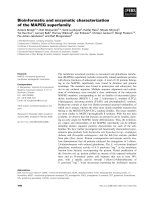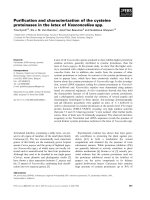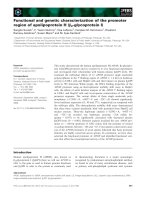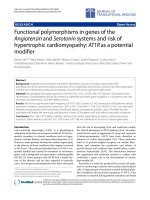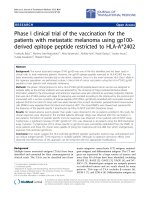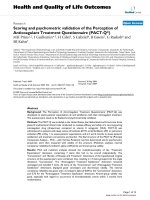báo cáo hóa học:" Carbon nanohorn-based nanofluids: characterization of the spectral scattering albedo" pdf
Bạn đang xem bản rút gọn của tài liệu. Xem và tải ngay bản đầy đủ của tài liệu tại đây (247.39 KB, 12 trang )
This Provisional PDF corresponds to the article as it appeared upon acceptance. Fully formatted
PDF and full text (HTML) versions will be made available soon.
Carbon nanohorn-based nanofluids: characterization of the spectral scattering
albedo
Nanoscale Research Letters 2012, 7:96 doi:10.1186/1556-276X-7-96
Luca Mercatelli ()
Elisa Sani ()
Annalisa Giannini ()
Paola Di Ninni ()
Fabrizio Martelli ()
Giovanni Zaccanti ()
ISSN 1556-276X
Article type Nano Express
Submission date 7 November 2011
Acceptance date 1 February 2012
Publication date 1 February 2012
Article URL />This peer-reviewed article was published immediately upon acceptance. It can be downloaded,
printed and distributed freely for any purposes (see copyright notice below).
Articles in Nanoscale Research Letters are listed in PubMed and archived at PubMed Central.
For information about publishing your research in Nanoscale Research Letters go to
/>For information about other SpringerOpen publications go to
Nanoscale Research Letters
© 2012 Mercatelli et al. ; licensee Springer.
This is an open access article distributed under the terms of the Creative Commons Attribution License ( />which permits unrestricted use, distribution, and reproduction in any medium, provided the original work is properly cited.
1
Carbon nanohorn-based nanofluids: characterization of the spectral
scattering albedo
Luca Mercatelli
1
, Elisa Sani*
1
, Annalisa Giannini
1
, Paola Di Ninni
2
, Fabrizio
Martelli
2
, and Giovanni Zaccanti
2
1
National Research Council-National Institute of Optics (CNR-INO), Largo E. Fermi,
6, Florence, 50125, Italy
2
Department of Physics and Astronomy, University of Florence, via Sansone 1, Sesto
Fiorentino, 50019, Italy
*Corresponding author:
Email addresses:
LM:
ES:
AG:
PDN
FM:
GZ:
Abstract
The full characterization of the optical properties of nanofluids consisting of single-
wall carbon nanohorns of different morphologies in aqueous suspensions is carried
out using a novel spectrophotometric technique. Information on the nanofluid
scattering and absorption spectral characteristics is obtained by analyzing the data
within the single scattering theory and validating the method by comparison with
previous monochromatic measurements performed with a different technique. The
high absorption coefficient measured joint to the very low scattering albedo opens
promising application perspectives for single-wall carbon nanohorn-based fluid or
solid suspensions. The proposed approximate approach can be extended also to other
low-scattering turbid media.
PACS: 78.35.+c Brillouin and Rayleigh scattering, other light scattering; 78.40.Ri
absorption and reflection spectra, fullerenes and related materials; 81.05.U-
carbon/carbon-based materials; 78.67.Bf optical properties of low-dimensional,
mesoscopic, and nanoscale materials and structures, nanocrystals, nanoparticles, and
nanoclusters.
Introduction
Single-wall carbon nanohorns [SWCNHs] are carbon nanostructures belonging to the
family of carbon nanotubes. They consist of single layers of a graphene sheet
wrapped into an irregular tubule with a variable diameter of 2 to 5 nm and a length of
30 to 50 nm, with cone-shaped tips [1-3]. The SWCNHs assemble to form roughly
spherical aggregates with typical diameters of about 100 to 120 nm with three
2
characteristic morphologies: dahlia-like, bud-like, and seed-like [3]. They exhibit both
a large surface area and a large number of cavities [4] and therefore appear promising
for a large variety of applications, including gas storage [5], drug delivery, [6] and
solar energy [7, 8]. When the differences between SWCNHs and better-known carbon
nanotubes are concerned, the absence of metals in SWCNHs (which are needed to
catalyze nanotube growth) makes their cytotoxicity negligible [9]. Moreover, the
minimum van der Waals interactions between the superstructures of SWCNH
aggregates give rise to a better dispersion of SWCNHs in liquid media [10] and a
much longer time stability of their suspensions. In fact, SWCNH aqueous suspensions
have been demonstrated to be very stable [7] also when compared to more
conventional carbon forms like amorphous carbon [11]. Recently, we studied
SWCNH-based nanofluids, proposing them as direct absorber and heat exchange
medium for solar collector applications [9], and we measured the scattering albedo at
some Vis-near infrared [NIR] wavelengths [12]. The low albedo values measured
could open interesting perspectives of applications for this kind of nanomaterial also
in other different fields.
In the present paper, we propose a spectrophotometric method for the spectral
evaluation of the scattering albedo of SWCNH aqueous suspension. The results
obtained with the proposed method have been compared to those recently obtained at
some discrete wavelengths using a different technique [8, 12], showing a fair
agreement.
Materials and methods
SWCNHs were produced with a patented method [13], able to selectively produce
different morphologies of SWCNHs (dahlia-like, bud-like, and seed-like). Some
dispersant is necessary to avoid aggregation of nanoparticles in water, and sodium n-
dodecyl sulfate (99%, Alfa Aesar, Ward Hill, MA, USA) was demonstrated to be the
best dispersant for this kind of carbon nanostructure [14]. For the present work, we
used two SWCNH suspensions, with dahlia- and bud-like nanohorn morphologies,
labeled in the following as D and B, respectively. Both suspensions had the same
nanoparticle concentration (0.3 g/l) and the same surfactant concentration (1.8 g/l).
The spectral scattering albedo has been obtained from spectrophotometric
measurements carried out by means of a double-beam spectrophotometer (Lambda
900, PerkinElmer, Waltham, MA, USA) equipped with an integrating sphere for the
measurement of transmittance (∅ = 150 mm, radius of the input aperture: R = 9.5
mm). A specially designed sample cell was manufactured. The cell dimensions
(surface, 95 × 40 mm
2
; thickness, L = 5 mm) were chosen in such a way to provide
enough internal volume to allow several additions of SWCNH suspensions to pure
water and to provide low noise curves with several data points for the chosen
experimental method (see below).
3
The method we propose consists of measuring the transmittance for different
concentrations of SWCNH (six progressive additions to pure water of a known
amount of the original undiluted concentration). For each concentration, the
measurement is repeated with the cell at two different distances from the integrating
sphere: with the cell ‘far’ at a distance (d
far
= 160 mm) and with the cell ‘near’ the
integrating sphere, in contact with the aperture (d
near
= 0 mm). The two measurements
differ for the different fractions of scattered received power. The scattering albedo is
obtained from these measurements, making the assumption that the SWCNH particles
are sufficiently small with respect to the wavelength, so their scattering function can
be approximated with the Rayleigh scattering function.
The expression for the scattering albedo has been obtained starting from the power P
R
received by the integrating sphere, which is given by:
R 0 S
P P P
= +
, (1)
where P
0
is the ballistic component, and P
S
is the fraction of scattered power that
enters the integrating sphere. With reference to Figure 1, P
0
is related to the
impinging power P
e
by:
0
( 0)
e
L
e
P T P e
µ
θ
−
= = , (2)
where T(θ = 0) is the transmittance of the cell windows (that takes into account the
losses due to Fresnel reflections for normal incidence), and µ
e
is the extinction
coefficient. We remind that µ
e
is the sum of the scattering (µ
s
) and absorption (µ
a
)
coefficients, and the scattering albedo ω is defined as the ratio ω = µ
s
/ µ
e
. The
extinction coefficient, being proportional to the particle concentration, can be
expressed as µ
e
= ε
e
ρ, where ρ is the concentration of SWCNH particles (in grams per
liter) and ε
e
, their specific extinction coefficient (per millimeter per (gram per liter)).
Measurements have been carried out for moderate values of the optical thickness τ
e
=
µ
e
L (<2.5). For these values of τ
e
and for the low values expected for the scattering
albedo (ω < 0.1), the scattered power is dominated by the contribution P
S1
due to
single scattering, so P
S
≅ P
S1
. P
S1
is given by [15]:
( ) ( )
e e
( , )
S1 e e 0 e
0 0
2 sin ( )
L
z l z
P P e p T e d dz P L
α
µ µ θ
ωµ π θ θ θ θ µ ω α
− −
= = ℑ
∫ ∫
, (3)
where p(θ) is the scattering function, l(z,θ) = (L−z) / cosθ, and
( )
( )
( )
( )
1
1
cos
0 0
1
( ) 2 sin
0
e
L
L z
T
p e d dz
L T
α
µ
θ
θ
α π θ θ θ
θ
− − −
ℑ =
=
∫∫
, (4)
The angle α is the largest value of θ for which photons can be detected after a single
scattering event. It is determined by total reflection at the water-glass-air interface,
and its values are α
near
= 48.7° for the near position and α
far
= 2.55° for the far one.
4
If it is possible to assume that
(
)
/cos
( )
e
e
µ L z
µ L z
e e
θ
− −
− −
≅ , then ℑ(α) becomes independent
on µ
e
and consequently on the concentration ρ. This approximation means that the
attenuation after a scattering event at point z on the optical axis, due to the path in the
cell that exceeds the remaining path (L−z), can be disregarded. This hypothesis will
be discussed in more detail below. Under this approximation, ℑ(α) becomes:
0
1
( ) 2 ( )sin ( ) / ( 0)
p T T d
L
α
α π θ θ θ θ θ
ℑ ≅ =
∫
. (5)
The power received for a ρ concentration of SWCNH can be written as:
e
R e e
( , ) ( 0) [1 ( )]
L
P T P e L
ε ρ
ρ α θ ε ρ ω α
−
≅ = + ℑ , (6)
and being
(
)
e
1
L
ε ρ ω α
ℑ <<
(low scattering regime and albedo < 0.1), we have
[
]
[
]
R e e
ln ( , ) 1 ( ) ln ( 0)
P L T P
ρ α ε ρ ω α θ
≅ − − ℑ + =
. (7)
We measured the sample transmittance at six different concentrations. From Equation
7, it is possible to obtain the measured intrinsic extinction coefficient ε
e meas
from the
slope of lnP
R
(ρ,α) as a function of ρ:
e meas e
( ) [1 ( )]
ε α ε ω α
= − ℑ . (8)
Finally, the albedo can be obtained as:
[ ] [ ]
e meas far e meas near e meas far e meas near
e near far e meas far near far
( ) ( ) ( ) ( )
( ) ( ) ( ) ( ) ( )
ε α ε α ε α ε α
ω
ε α α ε α α α
− −
= ≅
ℑ − ℑ ℑ − ℑ
, (9)
where we assumed that
e e meas far
( )
ε ε α
≅ . To obtain ω, it is therefore necessary to
assume a model for the scattering function in order to evaluate ℑ(α). As mentioned
before, for the SWCNH particles, we considered the Rayleigh scattering function
( )
2
3
[1 cos ]
16
p
θ θ
π
= +
.
5
Equation 9 has been obtained, making some assumptions that need to be summarized
and discussed. They, enumerated in order of importance, are (1) the Rayleigh
scattering function for the SWCNH particles, (2)
ℑ(α) independent on the extinction
coefficient (Equation 5), (3)
S S1
P P
≅
, (4) negligible effect of internal reflections, (5)
(
)
e
1
L
ε ρ ω α
ℑ <<
, and (6)
e e meas far
( )
ε ε α
≅ .
As for hypothesis (1), the Rayleigh scattering is probably not strictly applicable to
SWCNHs especially at short wavelengths. Anyway, it should be noticed that the
Rayleigh scattering function is nearly isotropic, while different scattering functions
become more and more forward-peaked as the size of particles increases. Therefore,
the value of ℑ(α) we obtained in hypothesis (1) represents the lower limit, and the
resulting value of the scattering albedo can be overestimated, thus representing a
higher limit for the albedo itself. To evaluate the error due to this approximation, we
calculated ℑ(α) using the Mie scattering function for a graphite sphere with a
diameter of 100 nm immersed in water. The values we obtained in this case both for
ℑ(α
far
) and ℑ(α
near
) were 74%, 20%, and 9% higher than those of the Rayleigh
scattering at λ = 350, 600, and 850 nm, respectively. However, it should be noticed
that actual nanoparticles, being aggregates of individual SWCNHs, are strongly
nonhomogeneous, and the Mie theory neither is strictly applicable. Their morphology
could suggest, as for the light-particle interaction, a sort of effective radius, smaller
than the physical radius.
Assumption (2) has been evaluated comparing the approximated values of ℑ(α)
obtained from Equation 5 with the exact values obtained from Equation 4. Values
calculated with Equation 5 are independent on µ
e
and equal to ℑ(α
far
) = 0.00075 and
6
ℑ(α
near
) = 0.206. Equation 4 has been calculated for the six values of µ
e
due to
progressive addition of SWCNHs: results for ℑ(α
far
) were almost identical to the
values obtained using Equation 5 in the calculation, while for ℑ(α
near
), we obtained a
value range from 0.180 to 0.198 at λ = 600 nm. In the worst case, this difference could
lead to relative errors of 10% to 15% in the albedo, which is acceptable in the
framework of the proposed estimation method aimed to assess a higher boundary.
Assumptions (3) and (4) have been investigated by means of Monte Carlo
simulations. We calculated the transmittance for different values of τ
e
ranging from
0.2 to 2.5, using a code for photon migration through a three-layer slab in which
multiple scattering and internal reflections are taken into account [16]. For the turbid
medium, we assumed the Rayleigh scattering function and ω = 0.1, and we
considered the same geometry as the experiment. The results do not differ if
assumptions either (3), (4), or both are made.
As for hypotheses (5) and (6), they do not appreciably affect the results. In fact,
numerical investigations showed that in all our experiments,
(
)
e
L
ε ρ ω α
ℑ was always
smaller than 0.025 (in fact, in writing
(
)
(
)
e e
ln[ 1]L L
ε ρ ω α ε ρ ω α
ℑ + = ℑ , we made the
hypothesis
(
)
e
1
rLw
ε α
ℑ <<
and that the difference between ε
e
and ε
e meas
(α
far
) was
smaller than 0.1%.
Results and discussion
The spectral extinction coefficient of an undiluted suspension of SWCNHs is
calculated for the two considered morphologies as described above. The results are
depicted in Figure 2a. In the same figure, we also show (hollow square and hollow
circle symbols) the values of ε
e
previously measured at three fixed wavelengths with a
different experimental apparatus based on laser sources. The details of the setup,
method, and results are reported elsewhere [12]. The agreement between
spectrophotometric and monochromatic methods is very good. From Figure 2a, we
can note that for both suspensions, the shorter is the wavelength, the higher is the
extinction coefficient, with a small difference between the two considered
morphologies.
The results for the albedo are reported in Figure 2b. In the same figure, we also show
the values obtained at
λ = 633, 751, and 833 nm with the different experimental
7
techniques cited above (multidistance measurement in an infinite diffusive medium
[8, 12]) for comparison. Also, in the case of albedo, the agreement between the two
considered experimental methods is satisfactory, taking into account that the
spectrophotometric method provides an upper limit for albedo within the Rayleigh
hypothesis as discussed. It should be emphasized that the spectrophotometric and
multidistance techniques are completely different. The latter [17] consists of adding
small amounts of the suspension under investigation to a previously calibrated
diffusive medium and of performing, within the resulting liquid, multidistance
measurements of fluence rate at fixed distances from an optical fiber radiating
isotropically. This technique is based on the solution of diffusion equation for an
infinite medium with known scattering properties, in which a small amount of the
medium under investigation is introduced in several steps. On the contrary, the
spectrophotometric technique needs no reference suspension and no previous
calibration even if it requires some hypothesis about the scattering function.
The proposed technique could be of interest for all applications requiring the
characterization of light-scattering properties of suspensions, like solar energy
exploitation and biological tissue optics. As for this latter application, the results of
our investigations on SWCNH suspensions show that they can be promising,
especially when they are compared to absorber materials currently used in liquid
phantoms, i.e., Indian inks [17]. It should be emphasized that literature values of
scattering albedo for Indian inks at NIR wavelengths lie between 10% and 16%. For
this reason, the ink behavior is far from that of an ideal absorber whose properties are
a high absorption coefficient and a 0% scattering. In this framework, SWCNH-based
nanofluids, thanks to their low albedo values, have the potential to be an excellent
absorbing standard for biological tissue optics.
Conclusions
In this paper, a simple spectrophotometric method is applied to the calculation of the
spectral scattering albedo of SWCNHs. The results show a satisfactory agreement
with those obtained from monochromatic measurements reported in the literature and
performed with a different technique. Thus, the present paper confirms that SWCNHs
have a very low scattering albedo (not higher than 5% for red and NIR wavelengths)
as compared to Indian inks (about 10% to 16% scattering). Moreover, the scattering
behavior of SWCNHs shows little dependence on the nanohorn morphology (dahlia-
like or bud-like). These results are very interesting to assess the SWCNH potential in
different applications, like for example, their use as absorbing standard in biological
tissue-simulating phantoms, for the calibration of noninvasive diagnostic optical
devices. Moreover, SWCNH suspensions show good stability properties as confirmed
by preliminary measurements we performed over a period of 1 year.
Competing interests
The authors declare that they have no competing interests.
Authors' contributions
8
LM, ES, AG, and PDN performed the spectrophotometric measurements and data
analysis. FM and GZ were involved in the theoretical modeling. All authors read and
approved the final manuscript.
References
1. Iijima S, Yudasaka M, Yamada R, Bandow S, Suenaga K, Kokai F, Takahashi K:
Nano-aggregates of single-walled graphitic carbon nano-horns. Chem Phys
Letters 1999, 309:165-170.
2. Murata K, Kaneko K, Kokai F, Takahashi K, Yudasaka M, Iijima S: Pore
structure of single-wall carbon nanohorn aggregates. Chem Phys Letters 2000,
331:14-20.
3. Yudasaka M, Iijima S, Crespi VH: Single-wall carbon nanohorns and
nanocones. In Carbon Nanotubes Topics in Applied Physics. Volume 111. Edited
by Jorio A, Dresselhaus G, Dresselhaus MS. Berlin/Heidelberg: Springer;
2008:605-629.
4. Fan X, Tan J, Zhang G, Zhang F: Isolation of carbon nanohorn assemblies and
their potential for intracellular delivery. Nanotechnology 2007, 18:195103.
5. Bekyarova E, Murata K, Yudasaka M, Kasuya D, Iijima S, Tanaka H, Kahoh H,
Kaneko K: Single-wall nanostructured carbon for methane storage. J Phys
Chem B 2003, 107:4682-4684.
6. Ajima K, Yudasaka M, Murakami T, Maigne A, Shiba K, Iijima S: Carbon
nanohorns as anticancer drug carriers. Mol Pharm 2005, 2:475-480.
7. Sani E, Barison S, Pagura C, Mercatelli L, Sansoni P, Fontani D, Jafrancesco D,
Francini F: Carbon nanohorns-based nanofluids as direct sunlight absorbers.
Opt Expr 2000, 18:5180-5187.
8. Mercatelli L, Sani E, Zaccanti G, Martelli F, Di Ninni P, Barison S, Pagura C,
Agresti F, Jafrancesco D: Absorption and scattering properties of carbon
nanohorn-based nanofluids for direct sunlight absorbers. Nanoscale Res Lett
2011, 6:282.
9. Lynch RM, Voy BH, Glass DF, Mahurin SM, Zhao B, Hu H, Saxton AM, Donnell
RL, Cheng MD: Assessing the pulmonary toxicity of single-walled carbon
nanohorns. Nanotoxicology 2007, 1:157-166.
10. Pagona G, Sandanayaka ASD, Araki Y, Fan J, Tagmatarchis N, Yudasaka M,
Iijima S, Ito O: Electronic interplay on illuminated aqueous carbon nanohorn-
porphyrin ensembles. J Phys Chem B 2006, 110:20729-20732.
11. Sani E, Mercatelli L, Barison S, Pagura C, Agresti F, Colla L, Sansoni P:
Potential of carbon nanohorn-based suspensions for solar thermal collectors.
Sol Energ Mater Sol Cell 2011, 95:2994-3000.
12. Mercatelli L, Sani E, Fontani D, Zaccanti G, Martelli F, Di Ninni P: Scattering
and absorption properties of carbon nanohorn-based nanofluids for solar
energy applications. J Eur Opt Soc-Rapid Publ 2011, 6:11025.
13. Schiavon M: Device and method for production of carbon nanotubes, fullerene
and their derivatives. U.S. Patent 7, 125,525; EP 1428794.
14. Fedele L, Colla L, Bobbo S, Barison S, Agresti F: Experimental stability
analysis of different water-based nanofluids. Nanoscale Res Lett 2011, 6:300.
15. Zaccanti G, Bruscaglioni P: Deviation from the Lambert-Beer law in the
transmittance of a light beam through diffusing media: experimental results.
J Modern Opt 1988, 35:229-242.
9
16. Martelli F, Del Bianco S, Ismaelli A, Zaccanti G: Light Propagation Through
Biological Tissue and Other Diffusive Media: Theory, Solutions, and Software.
Bellingham: SPIE Press; 2010.
17. Di Ninni P, Martelli F, Zaccanti G:
The use of India ink in tissue-simulating
phantoms. Opt Expr 2010, 18:26854-65.
Figure 1. Geometry used for the model.
Figure 2. Spectral extinction coefficient (a) and fitted albedo values (b), with
error bars (gray bars). Hollow squares (B) and hollow circles (D) in both images
show the results of monochromatic measurements performed with the multidistance
method. D and B label dahlia-like and bud-like SWCNH morphologies, respectively.
Figure 1
Figure 2

